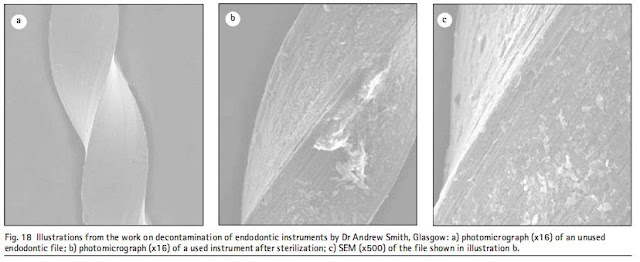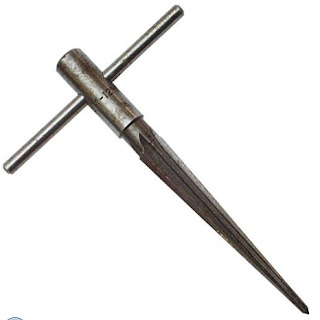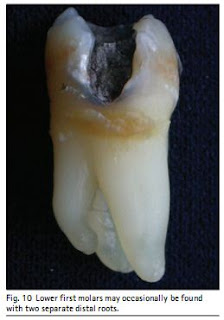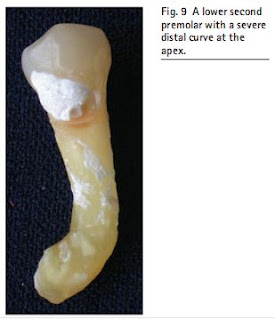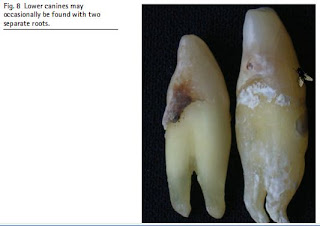There is often a history of spontaneous bouts of pain which may last from a few seconds up to several hours. When hot or cold fluids are applied, the pain elicited will be prolonged. In the later stages, heat will be more significant; cold may relieve the pain. Pain may radiate initially, but once the periodontal ligament has become involved, the patient will be able to locate the tooth.
The tooth becomes tender to percussion once inflammation has spread to the periodontal ligament. A widened periodontal ligament may be seen on the radiographs in the later stages. Careful evaluation of a patient s dental history and of each test is important. Any one test on its own is an insufficient basis on which to make a diagnosis. Records and radiographs should first be checked for any relevant information such as deep caries, pinned restorations, and the appearance of the periodontal ligament space (Fig. 1).

Vitality tests can be misleading, as various factors have to be taken into account. For example, the response in an older person may differ from that in someone younger due to secondary dentine deposition and other atrophic changes in the pulp tissue. Electric pulp testing is simply an indication of the presence of vital nerve tissue in the root canal system only and not an indication of the state of health of the pulp tissue Once pulpal inflammation has spread to the periodontal ligament, the resulting inflammatory exudate may cause extrusion of the tooth, making it tender to bite on. This particular symptom, acute apical periodontitis, may be a consequence of occlusal trauma; the occlusion must therefore always be checked.
Ideally, the treatment for irreversible pulpitis is pulp extirpation followed by cleaning and preparation of the root canal system. If time does not permit this, then removal of pulp tissue from the pulp chamber and from the coronal part of the root canal is often effective. Irrigation of the pulp chamber using a solution of sodium hypochlorite before carrying out any instrumentation is important. (Sodium hypochlorite is usually sold as a 5% solution. This may be diluted with purified water BP to the operator s preference.) Sodium hypochlorite solution has proved to be one of the most effective disinfecting agents used in root canal treatment,
7,8
with different authors recommending strengths between 0.5 and 5.0%. The pulp chamber and root canals are dried, and a dry sterile cotton wool pledget placed in the pulp chamber with a temporary filling to seal the access cavity. Antiseptic solutions such as phenolic solutions or corticosteroid/ antibiotic preparations on cotton wool pledgets have been advocated, but their effectiveness is of doubtful value. Corticosteroid dressings should be used sparingly as there is evidence that suppression of an inflammatory response by steroids allows bacteria to enter the bloodstream with ease.
This is a particularly undesirable effect in patients who, for example, have a history of rheumatic fever. Studies have shown that provided the pulp chamber and the root canals have been cleansed and dried, medication of the pulp chamber and root canals is of little practical benefit. Paper points are used to dry the canals and under no circumstances should they be left in the canal, otherwise any fluid that enters the canal system will be absorbed and so provide an effective culture medium for any residual bacteria.
Difficulty with local analgesia is a common problem with an acutely inflamed pulp. In
Fig. 3 to a large, well-defined area of radiolucency.
addition to standard techniques, supplementary analgesia can be obtained with the following:
1 Additional infiltration anaesthesia, such as long-buccal, lingual and palatal.
2 Intraligamental (intra-osseous) injection. 3 True intra-osseous injection. 4 Intrapulpal analgesia. 5 Inhalational sedation with local analgesia.
Should these techniques give only moderate success, it is advisable to dress the pulp to allow the inflammation to subside and to postpone pulp extirpation. A corticosteroid/antibiotic preparation with a zinc oxide/eugenol temporary restoration will provide an effective, shortterm dressing.
Continuation of pain following pulp extirpation may be due to one of the following causes.
1 The temporary filling is high.
2 Infected pulp tissue is present in the canal.
3 Some of the canal contents have been
extruded through the apex.
4 Overinstrumentation of the apex or perfora-
tion of the canal wall.
5 An extra canal may be present which has not
been cleaned. If the problem is not found to be occlusal,
whatever the cause the remedy is to irrigate the pulp chamber and root canal system again with sodium hypochlorite solution and perhaps gently instrument, then dry and redress the tooth as before.Once pulpal inflammation has spread to the periodontal ligament, the resulting inflammatory exudate may cause extrusion of the tooth, making it tender to bite on. This particular symptom, acute apical periodontitis, may be a consequence of occlusal trauma; the occlusion must therefore always be checked.
Ideally, the treatment for irreversible pulpitis is pulp extirpation followed by cleaning and preparation of the root canal system. If time does not permit this, then removal of pulp tissue from the pulp chamber and from the coronal part of the root canal is often effective. Irrigation of the pulp chamber using a solution of sodium hypochlorite before carrying out any instrumentation is important. (Sodium hypochlorite is usually sold as a 5% solution. This may be diluted with purified water BP to the operator s preference.) Sodium hypochlorite solution has proved to be one of the most effective disinfecting agents used in root canal treatment, 7,8 with different authors recommending strengths between 0.5 and 5.0%. The pulp chamber and root canals are dried, and a dry sterile cotton wool pledget placed in the pulp chamber with a temporary filling to seal the access cavity. Antiseptic solutions such as phenolic solutions or corticosteroid/ antibiotic preparations on cotton wool pledgets have been advocated, but their effectiveness is of doubtful value. Corticosteroid dressings should be used sparingly as there is evidence that suppression of an inflammatory response by steroids allows bacteria to enter the bloodstream with ease.
